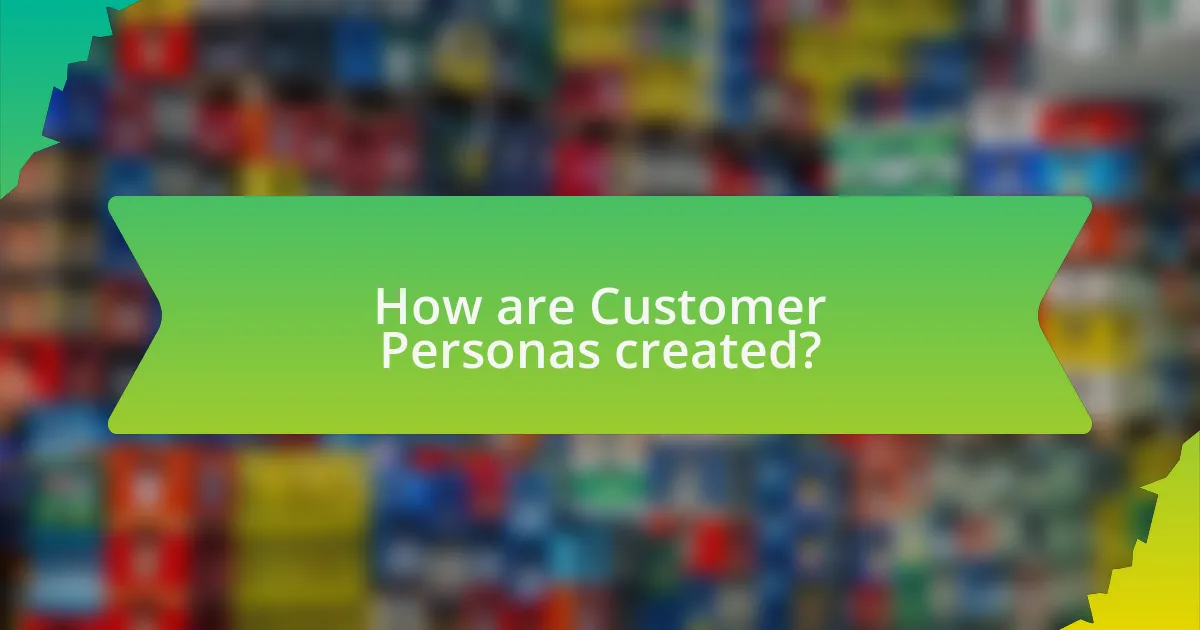Customer personas are detailed representations of a business’s ideal customers, developed through data analysis and market research. They play a crucial role in strategic marketing by helping businesses understand customer needs, preferences, and behaviors, which enables the creation of targeted marketing strategies. The article outlines how customer personas are defined, their key characteristics, and their importance in enhancing marketing effectiveness, including improved engagement and conversion rates. It also discusses the methods for creating accurate personas, the elements to include, and the challenges marketers face in utilizing them effectively. Additionally, the article highlights best practices for integrating customer personas into marketing campaigns to optimize resource allocation and drive sales.

What are Customer Personas in Strategic Marketing?
Customer personas in strategic marketing are detailed representations of a business’s ideal customers, created through data analysis and market research. These personas help marketers understand customer needs, preferences, and behaviors, enabling targeted marketing strategies. For instance, a study by HubSpot found that companies using buyer personas saw a 73% increase in conversion rates, demonstrating the effectiveness of this approach in aligning marketing efforts with customer expectations.
How are Customer Personas defined?
Customer personas are defined as semi-fictional representations of a business’s ideal customers, created based on market research and real data about existing customers. These personas typically include demographic information, behavioral patterns, motivations, and goals, which help businesses understand their target audience better. Research indicates that companies using customer personas can improve their marketing strategies by tailoring content and messaging to meet the specific needs and preferences of different segments, ultimately leading to increased engagement and conversion rates.
What key characteristics define a Customer Persona?
A Customer Persona is defined by key characteristics such as demographics, behaviors, motivations, and pain points. Demographics include age, gender, income, and education level, which help in segmenting the target audience. Behaviors encompass purchasing habits and brand interactions, providing insights into how customers engage with products or services. Motivations reveal what drives customers to make decisions, while pain points identify challenges or issues that the persona seeks to resolve. These characteristics are essential for creating effective marketing strategies, as they enable businesses to tailor their messaging and offerings to meet the specific needs of their target audience.
How do Customer Personas differ from target audiences?
Customer personas differ from target audiences in that personas are detailed, semi-fictional representations of ideal customers based on qualitative and quantitative data, while target audiences are broader groups defined by demographic characteristics. Customer personas provide insights into motivations, behaviors, and preferences, allowing for tailored marketing strategies, whereas target audiences focus on general traits like age, gender, and location. For example, a customer persona might include specific interests and pain points, derived from customer interviews and surveys, while a target audience might simply be defined as “women aged 25-34.” This distinction enables marketers to create more personalized and effective campaigns that resonate with specific segments of their audience.
Why are Customer Personas important in marketing strategies?
Customer personas are important in marketing strategies because they provide a detailed representation of target customers, enabling marketers to tailor their campaigns effectively. By understanding the demographics, behaviors, and preferences of specific customer segments, businesses can create personalized messaging and product offerings that resonate with their audience. Research indicates that companies using customer personas in their marketing strategies see a 10% increase in conversion rates, as these personas help in aligning marketing efforts with customer needs and expectations. This alignment leads to more effective communication and higher customer engagement, ultimately driving sales and brand loyalty.
What role do Customer Personas play in understanding customer needs?
Customer personas play a crucial role in understanding customer needs by providing detailed representations of target audiences based on data and research. These personas help businesses identify specific characteristics, preferences, and pain points of different customer segments, enabling tailored marketing strategies. For instance, a study by HubSpot found that companies using buyer personas saw a 124% increase in lead generation, demonstrating the effectiveness of personas in aligning marketing efforts with actual customer needs.
How do Customer Personas influence marketing messaging?
Customer personas significantly influence marketing messaging by providing a detailed representation of target audiences, which allows marketers to tailor their communication strategies effectively. By understanding the demographics, behaviors, and preferences of specific customer segments, marketers can create personalized messages that resonate with their audience. Research indicates that personalized marketing can lead to a 20% increase in sales, demonstrating the effectiveness of using customer personas to refine messaging. This targeted approach not only enhances engagement but also improves conversion rates, as messages aligned with customer needs and interests are more likely to drive action.

How are Customer Personas created?
Customer personas are created through a systematic process that involves gathering and analyzing data about target customers. This process typically includes conducting market research, utilizing surveys, and analyzing customer behavior and demographics to identify patterns and preferences. For instance, companies often use tools like Google Analytics and social media insights to collect quantitative data, while qualitative data can be gathered through interviews and focus groups. By synthesizing this information, marketers can develop detailed profiles that represent distinct segments of their audience, which helps in tailoring marketing strategies effectively.
What research methods are used to develop Customer Personas?
Qualitative and quantitative research methods are used to develop Customer Personas. Qualitative methods include interviews, focus groups, and ethnographic studies, which provide in-depth insights into customer motivations and behaviors. Quantitative methods involve surveys and data analysis, allowing marketers to gather statistical information about customer demographics and preferences. For instance, a study by the Nielsen Norman Group highlights that combining qualitative insights with quantitative data leads to more accurate and actionable personas, enhancing marketing strategies.
How can surveys and interviews contribute to persona development?
Surveys and interviews significantly contribute to persona development by providing direct insights into customer behaviors, preferences, and motivations. These qualitative and quantitative methods allow marketers to gather detailed information about target audiences, which can be analyzed to identify patterns and trends. For instance, surveys can quantify customer satisfaction levels, while interviews can explore deeper emotional drivers behind purchasing decisions. Research indicates that companies utilizing customer insights from surveys and interviews can enhance their marketing strategies, leading to a 20% increase in customer engagement and a 15% boost in conversion rates. This data-driven approach ensures that personas are not only based on assumptions but are grounded in real customer experiences and feedback.
What role does data analysis play in creating accurate personas?
Data analysis is crucial in creating accurate personas as it provides empirical insights into customer behaviors, preferences, and demographics. By analyzing data from various sources such as surveys, social media interactions, and purchase histories, marketers can identify patterns and trends that inform the development of detailed and representative customer personas. For instance, a study by HubSpot found that companies using data-driven personas saw a 73% increase in marketing effectiveness, demonstrating the tangible benefits of leveraging data analysis in persona creation.
What elements should be included in a Customer Persona?
A Customer Persona should include demographic information, psychographics, behavioral traits, pain points, goals, and purchasing habits. Demographic information encompasses age, gender, income, education, and location, which helps in identifying the target audience. Psychographics delve into personality traits, values, interests, and lifestyle choices, providing insight into motivations. Behavioral traits focus on how customers interact with products or services, including usage patterns and brand loyalty. Pain points identify specific challenges or problems the customer faces, while goals outline what they aim to achieve. Lastly, purchasing habits reveal how and when customers make buying decisions, which is crucial for tailoring marketing strategies. These elements collectively create a comprehensive understanding of the customer, enabling effective marketing strategies.
What demographic information is essential for a Customer Persona?
Essential demographic information for a Customer Persona includes age, gender, income level, education level, marital status, and geographic location. These factors help marketers understand the target audience’s characteristics and preferences, enabling more effective segmentation and tailored marketing strategies. For instance, a study by HubSpot found that 71% of marketers who exceed their revenue and lead goals use buyer personas, highlighting the importance of demographic data in creating effective customer profiles.
How do psychographics enhance the understanding of Customer Personas?
Psychographics enhance the understanding of Customer Personas by providing insights into consumers’ values, interests, and lifestyles, which go beyond basic demographic data. This deeper understanding allows marketers to create more targeted and effective strategies that resonate with specific segments of the audience. For instance, research by the American Marketing Association indicates that psychographic segmentation can lead to a 20% increase in marketing effectiveness, as it aligns messaging with the emotional and psychological drivers of consumer behavior. By integrating psychographics into Customer Personas, businesses can tailor their offerings and communication strategies to meet the nuanced needs of their target market, ultimately improving engagement and conversion rates.

How do Customer Personas impact marketing effectiveness?
Customer personas significantly enhance marketing effectiveness by enabling targeted messaging and personalized experiences. By defining specific characteristics, behaviors, and needs of different customer segments, businesses can tailor their marketing strategies to resonate with each persona. Research indicates that companies utilizing customer personas see a 10% increase in conversion rates, as campaigns become more relevant and engaging. This targeted approach not only improves customer engagement but also optimizes resource allocation, leading to higher return on investment (ROI) in marketing efforts.
What benefits do businesses gain from using Customer Personas?
Businesses gain several benefits from using Customer Personas, including enhanced targeting, improved product development, and increased customer engagement. By creating detailed profiles of their ideal customers, businesses can tailor their marketing strategies to meet specific needs and preferences, leading to more effective campaigns. Research indicates that companies using personas see a 73% increase in customer satisfaction, as they can better align their offerings with customer expectations. Additionally, Customer Personas facilitate more efficient resource allocation, allowing businesses to focus their efforts on high-value segments, ultimately driving higher conversion rates and revenue growth.
How do Customer Personas improve customer engagement?
Customer personas improve customer engagement by enabling businesses to tailor their marketing strategies to specific audience segments. By understanding the demographics, preferences, and behaviors of different customer personas, companies can create personalized content and experiences that resonate with their target audience. Research indicates that personalized marketing can lead to a 20% increase in sales, as customers are more likely to engage with brands that understand their needs and interests. This targeted approach not only enhances customer satisfaction but also fosters loyalty, as customers feel valued and understood.
What impact do Customer Personas have on conversion rates?
Customer personas significantly enhance conversion rates by enabling targeted marketing strategies that resonate with specific audience segments. By understanding the demographics, behaviors, and preferences of potential customers, businesses can tailor their messaging and offers to meet the unique needs of each persona. Research indicates that companies utilizing customer personas experience conversion rate increases of up to 73%, as they can create more relevant and personalized experiences. This targeted approach not only improves engagement but also fosters trust and loyalty, ultimately leading to higher sales and customer retention.
How can businesses effectively implement Customer Personas in their strategies?
Businesses can effectively implement Customer Personas in their strategies by integrating detailed personas into their marketing plans, ensuring that all team members understand and utilize these personas in decision-making. This integration involves conducting thorough research to create accurate personas based on demographic data, behavioral insights, and customer feedback, which allows businesses to tailor their messaging and product offerings to meet the specific needs of their target audience. For instance, a study by HubSpot found that companies using buyer personas saw a 124% increase in lead generation, demonstrating the effectiveness of this approach in enhancing marketing outcomes.
What are best practices for integrating Customer Personas into marketing campaigns?
Best practices for integrating Customer Personas into marketing campaigns include aligning marketing messages with the specific needs and preferences of each persona, utilizing data-driven insights to refine targeting strategies, and continuously testing and optimizing campaigns based on persona performance. Research indicates that companies using customer personas in their marketing strategies can achieve up to 73% higher conversion rates, as they tailor their messaging to resonate with distinct audience segments. By regularly updating personas based on customer feedback and market trends, businesses can ensure their campaigns remain relevant and effective.
How can Customer Personas be used to tailor content marketing efforts?
Customer personas can be used to tailor content marketing efforts by providing detailed insights into the target audience’s preferences, behaviors, and pain points. By analyzing these personas, marketers can create content that resonates specifically with different segments of their audience, ensuring relevance and engagement. For instance, a study by HubSpot found that companies using buyer personas saw a 124% increase in lead generation, demonstrating the effectiveness of personalized content strategies. This data underscores the importance of aligning content with the specific needs and interests of identified customer personas, ultimately enhancing the overall impact of marketing campaigns.
What common challenges do marketers face when using Customer Personas?
Marketers commonly face challenges such as inaccurate data, oversimplification, and lack of alignment with business goals when using Customer Personas. Inaccurate data can lead to the creation of personas that do not truly represent the target audience, resulting in ineffective marketing strategies. Oversimplification occurs when marketers reduce complex customer behaviors and motivations into overly simplistic personas, which can overlook critical nuances. Additionally, a lack of alignment with business goals can cause marketers to develop personas that do not support the overall strategic objectives of the organization, leading to wasted resources and missed opportunities. These challenges highlight the importance of thorough research and continuous updates to ensure that Customer Personas remain relevant and effective.
How can businesses overcome inaccuracies in Customer Personas?
Businesses can overcome inaccuracies in Customer Personas by regularly updating and validating their data through customer feedback and analytics. This approach ensures that personas reflect current customer behaviors and preferences. For instance, utilizing surveys and interviews can provide direct insights into customer needs, while analyzing website and social media engagement metrics can reveal shifts in interests. Research indicates that companies that actively refine their customer personas based on real-time data see a 10-20% increase in marketing effectiveness, demonstrating the importance of maintaining accurate and relevant personas.
What strategies can be employed to keep Customer Personas updated?
To keep Customer Personas updated, regularly collect and analyze customer data through surveys, interviews, and analytics tools. This approach ensures that the personas reflect current customer behaviors and preferences. For instance, a study by HubSpot found that companies that regularly update their customer personas see a 10-20% increase in marketing effectiveness. Additionally, monitoring social media trends and customer feedback can provide real-time insights, allowing businesses to adjust their personas accordingly. Implementing these strategies ensures that Customer Personas remain relevant and effective in guiding marketing efforts.
What are practical tips for leveraging Customer Personas in marketing?
To effectively leverage Customer Personas in marketing, businesses should first ensure that they create detailed and accurate personas based on comprehensive market research. This involves gathering data through surveys, interviews, and analytics to understand customer demographics, behaviors, and preferences. Once established, companies can tailor their marketing strategies to align with the specific needs and motivations of each persona, enhancing engagement and conversion rates. For instance, a study by HubSpot found that personalized marketing can lead to a 20% increase in sales. Additionally, regularly updating personas based on new data ensures that marketing efforts remain relevant and effective, as consumer preferences can shift over time.


